Related Research Articles
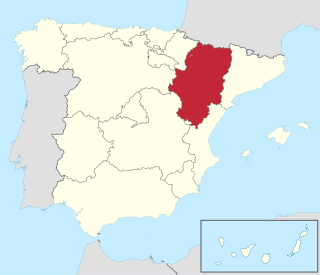
Aragon is an autonomous community in Spain, coextensive with the medieval Kingdom of Aragon. In northeastern Spain, the Aragonese autonomous community comprises three provinces : Huesca, Zaragoza, and Teruel. Its capital is Zaragoza. The current Statute of Autonomy declares Aragon a historic nationality of Spain.
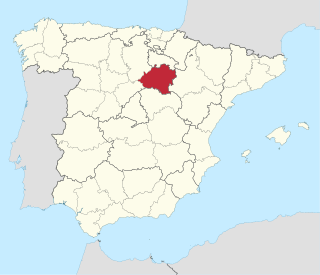
Soria is a province of central Spain, in the eastern part of the autonomous community of Castile and León. Most of the province is in the mountainous Sistema Ibérico area.
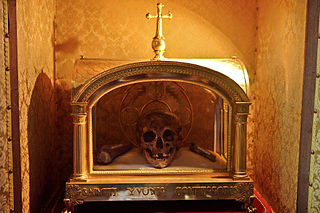
In religion, a relic is an object or article of religious significance from the past. It usually consists of the physical remains or personal effects of a saint or other person preserved for the purpose of veneration as a tangible memorial. Relics are an important aspect of some forms of Buddhism, Christianity, Islam, shamanism, and many other religions. Relic derives from the Latin reliquiae, meaning "remains", and a form of the Latin verb relinquere, to "leave behind, or abandon". A reliquary is a shrine that houses one or more religious relics.

Fermin was a legendary holy man and martyr, traditionally venerated as the co-patron saint of Navarre, Spain. His death may be associated with either the Decian persecution (250) or Diocletianic Persecution (303).

Stanislaus of Szczepanów was Bishop of Kraków known chiefly for having been martyred by the Polish King Bolesław II the Generous. Stanislaus is venerated in the Roman Catholic Church as Saint Stanislaus the Martyr.

Charbel Makhlouf, O.L.M., born Youssef Antoun Makhlouf and venerated as Saint Charbel, was a Maronite monk and priest from Lebanon. During his life, he obtained a wide reputation for holiness, and for his ability to unite Christians and Muslims and Druze.

Tarazona is a town and municipality in the Tarazona y el Moncayo comarca, province of Zaragoza, in Aragon, Spain. It is the capital of the Tarazona y el Moncayo Aragonese comarca. It is also the seat of the Roman Catholic Diocese of Tarazona.
Finan of Lindisfarne, also known as Saint Finan, was an Irish monk, trained at Iona Abbey in Scotland, who became the second bishop of Lindisfarne from 651 until 661.

The Diocese of Tarazona is a Latin diocese of the Catholic Church located in north-eastern Spain, in the provinces of Zaragoza, Soria, Navarre and La Rioja, forming part of the autonomous communities of Aragón, Castile-Leon, Navarre and La Rioja. The diocese forms part of the ecclesiastical province of Zaragoza, and is thus suffragan to the Archdiocese of Zaragoza.

Saint Valerius of Saragossa is the patron saint of Saragossa. He was bishop of this city from 290 until his death. He assisted at the Council of Elvira. His feast day is January 29.

Campo de Borja is a Spanish Denominación de Origen Protegida (DOP) for wines located in the Campo de Borja comarca, northwest of the province of Zaragoza. It is a transition zone between the plains of the River Ebro and the mountains of the Sistema Ibérico. The DOP comprises 16 municipalities. These are Ainzón, Agón, Albeta, Ambel, Bisimbre, Borja, Bulbuente, Bureta, Fréscano, Fuendejalón, Magallón, Maleján, Mallén, Pozuelo de Aragón, Tabuenca and Vera de Moncayo. The Moncayo mountain is the dominant feature of the DOP and creates a microclimate which gives the wines a special character.

Novallas is a municipality located in the province of Zaragoza, Aragon, Spain. It belongs to the "comarca" (county) of Tarazona y el Moncayo. According to the 2004 census (INE), the municipality has a population of 807 inhabitants.

Severus of Barcelona is venerated as a saint by the Catholic and Eastern Orthodox churches. His legend states that he was a bishop of Barcelona and was martyred during the persecution of Christians by Diocletian in AD 304. Details concerning his life and death are uncertain and of questionable historicity.

Damià Forment was a Valencian Spanish architect and sculptor, considered the most important Spanish sculptor of the 16th century.
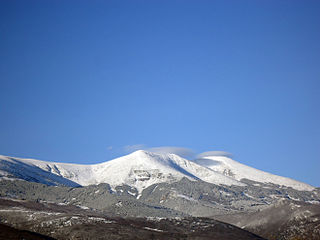
The Iberian System is one of the major systems of mountain ranges in Spain. It consists of a vast and complex area of mostly relatively high and rugged mountain chains and massifs located in the central region of the Iberian Peninsula, but reaching almost the Mediterranean coast in the Valencian Community in the east.

Moncayo is a 15 km long and about 7 km wide mountain chain giving name to the Tarazona y el Moncayo comarca, Aragon, Spain. The Moncayo's highest summit, San Miguel, is the highest point in the 500 km long Sistema Ibérico.
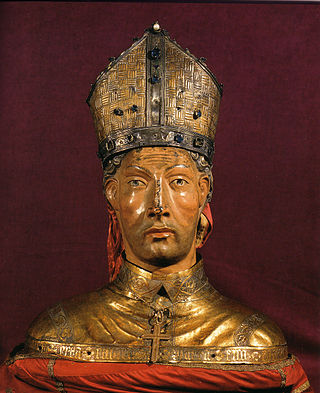
San Prudencio was a Spanish anchorite and cleric who was bishop over Tarazona. He has been the patron saint of Nájera and Álava since the mid-17th century. His festival is on 28 April.
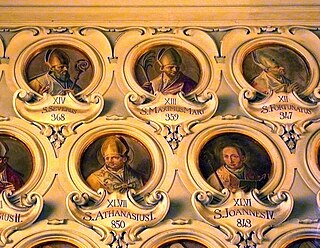
Fortunatus of Naples was a 4th-century Christian bishop. He is the first historically-attested bishop of Naples, as one of the recipients of a letter written by those who took part in the Arian Council of Philippopolis in the 340s - his tradition states he was a fierce opponent of Arianism. His term as bishop is traditionally held to be 347 to 359.

Goldrofe of Arganil, C.R.S.A. was a Portuguese Augustinian prior in what is today central Portugal. He is venerated as a saint in the Roman Catholic Church.
References
![]() This article incorporates text from a publication now in the public domain : Kirsch, J. P. (1913). "Gaudiosus". In Herbermann, Charles (ed.). Catholic Encyclopedia . New York: Robert Appleton Company. cites:
This article incorporates text from a publication now in the public domain : Kirsch, J. P. (1913). "Gaudiosus". In Herbermann, Charles (ed.). Catholic Encyclopedia . New York: Robert Appleton Company. cites:
- Acta SS., I, Nov., 664-65
- De la Fuente, La Santa Iglesia de Tarazona en sus Estados Antiguos y Modernos (Madrid, 1865).